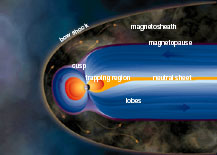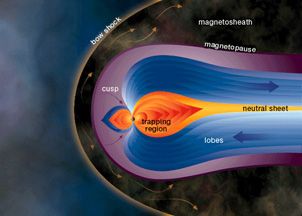The Force of Magnetism
You may ask, how does the force of Magnetism work?
The force of magnetism
is directed from one pole to another. A pole can be described as the point where lines of magnetic force come together.
Most simple magnets have two poles (that makes them "di-poles"), as shown in this picture. The magnetic field "lines" illustrate where the force of magnetism is, and whether it is stronger (red) or weaker (blue).

This is an illustration of how magnetism works.
Click on images for full size version (40K GIF)
|
For simple magnets, the force of magnetism works in the following way: When two magnets are brought together, the force will attract the two magnets together if the poles are opposite, that is if the pole of the first magnet is positive and the pole of the second magnet is negative. If that condition is true, the two magnets will be "forced" to stick together. |
 |
If two magnets of the same polarity are brought together, the force of magnetism will repel the two magnets from each other, and they cannot be made to stick together. |
 More on Magnetism
More on Magnetism
You might also be interested in:

The force of magnetism causes material to point along the direction the magnetic force points. As shown in the diagram to the left, the force of magnetism is illustrated by lines, which represent the force.
...more
The Earth has a magnetic field with north and south poles. The Earth's magnetic field reaches 36,000 miles into space. The magnetic field of the Earth is surrounded in a region called the magnetosphere.
...more
Earth has a magnetic field. If you imagine a gigantic bar magnet inside of Earth, you'll have a pretty good idea what Earth's magnetic field is shaped like. Of course, Earth DOESN'T have a giant bar magnet
...more
Earth has a magnetic field with a north pole and a south pole. Earth's magnetic field is pretty much (but not exactly) like the magnetic field around a bar magnet. Earth's North Magnetic Pole (NMP) is
...more
The Earth is a good example of a planetary dipole, where the lines of force point in a direction out of the South (magnetic) Pole and into the North (magnetic) Pole. Planets can also show evidence of quadrupoles
...more
A magnetometer is an instrument for measuring magnetic fields. Many spacecraft carry magnetometers to measure the magnetic fields around planets. When a spacecraft makes those measurements, what do the
...more
Electricity and magnetism are two very important topics in the science of physics. We use electricity to power computers and to make motors go. Magnetism makes a compass point North and keeps notes stuck
...more
















